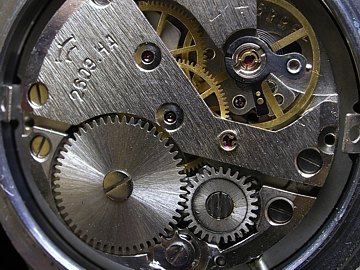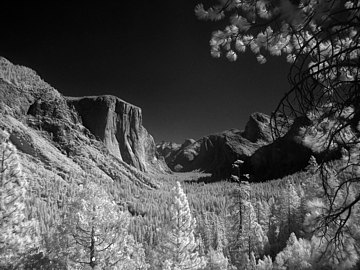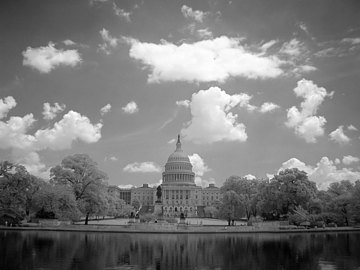Many photographers, digital or not, believe that an SLR offers more convenience and flexibility than other types of cameras. While generally this may be true (and I do not want to go into the whole argument on this), in the digital domain there are areas where a non-SLR will be a hands-down winner. Two applications come into mind: macrophotography and photography in infrared.
Macrophotography
When taking pictures of small objects (say, a few centimeters across) with a 35-mm camera, we are used to some technical complications and inconveniences. Most of them stem from the fact that the subject-to-lens distance becomes comparable to the focal length of the lens. This carries three implications.
- The lens, in order to focus on the subject, has to be greatly extended forwards. For example, to frame a field of 36 mm across, a "standard" 50-mm lens has to get an extra 50 mm extension as compared to focusing at infinity. This complicates the design, and therefore such extension is usually achieved with extension rings; lenses allowing to do it without rings (referred to as "macro" lenses"), as few of them as there are, are larger, heavier, and more expensive.
- It is easier to correct the lens optically under an assumption that the subject distance is much greater than the focal length. By "much greater" I understand at least one order of magnitude, i.e., a factor of ten. This is why most 35-mm cameras focus down to 50 cm or so. Using extension rings does not solve the problem - it only provides the extra extension. Once again, this is why the specialized "macro" lenses cost more, again.
- A relatively minor point: the nominal aperture is defined for the lens focused at infinity. The effective one decreases inverse-proportionally to the lens extension. In out 36 mm across-the-field example the aperture denominator (F-stop) should be multiplied by two.
No wonder that SLRs dominated the macro field in film photography: they offer interchangeable lenses (addressing point 1 above), and most have through-the-lens metering (addressing
But how different are things in digital cameras? Aren't laws of optics laws of optics?
There is just one difference here, but a very significant one: the digital camera sensor is smaller than a 35-mm film frame.
The difference is not so large in case of digital SLRs: most of the advanced-amateur models have a sensor about 1.6 times smaller, in terms of linear size, than a film frame, while the Four Thirds standard, introduced by Olympus, has a factor of two. For most practical purposes, digital SLRs are not so much different from 35-mm ones (and even less so from half-frame models, like the Pen F).
On the other hand, non-SLR models use sensors from four to seven times smaller than a film frame. To achieve the same image angle, the lens focal length has to be also four to seven times shorter (we will say that the lens equivalence ratio, N, is between 4 and 7).
Suddenly shooting a scene 36 mm across (our example above) becomes not so different than shooting one which is a meter wide.
The extra extension is no longer prohibitively large, the same subject distance (the same angle, remember?) becomes much larger than the focal length, no special correction necessary, and the exposure metering in these cameras is done through the lens (usually by the image sensor itself). All three points above become non-issues.
Olympus C-5060WZ; a full frame of about 29 mm across. 1 second at F/5.6, mini-tripod, household lights.
The focal length was 11.5 mm, providing the same image angle as a 58 mm lens on a film camera (equivalence ratio N=5).
(For an XGA version click here.)

The shorter focal length has one more implication: much greater depth of field. Skipping the details: if you are using a digital camera with N=5.6 (see above) at F/4.0, you will have the same depth of field as shooting with an OM-1, with a lens with the same viewing angle, stepped down to F/23 (4*5.6=23). While shallow depth of field can be used creatively, try to tell this to someone chasing a bee on a flower, with a camera hand-held. In macro applications DOF is your friend.
This is why many non-SLR digital cameras allow you to focus quite close: down to ten, or even three centimeters from the lens front, for a field of view until now available only to SLR users, and that with special equipment.
In particular, most Olympus models not only provide this feature (allowing you to get a field three centimeters wide), but the macro performance is just great - and this includes even many of the least expensive, entry-level models like the bottom-shelf, $250 Olympus C-460 clamshell (a.k.a. D-580), with the FOV just 28 mm across and a very pleasing performance.
This one was shot with my favorite Olympus compact, the C-5050WZ. A full frame is shown, about 3.5 cm across.
The picture was improvised, handheld. Focal length: 11.7 mm (equivalence ratio N=5), F/5.6 at 1/640s.
The same angle and DOF would be achieved on your OM-1 with a 58 mm lens stepped down to F/23.
(For an XGA version click here.)

Last but not least, all non-SLR digital cameras offer real-time viewing on the LCD monitor; this not only takes care of the parallax effect, but the preview is usually more convenient than through the SLR eyepiece. SLRs do not allow for real-time electronic viewing.
(Just for the record: the E-10 and E-20 Olympus SLRs of a few years ago are an exception here; not only do they have real-time LCD preview, using a beam splitter instead of a "normal" SLR mirror, but their CCD sensors are also much smaller than those in all other models, with the equivalence ratio, N=4.)
Infrared
I very much enjoyed Geoffrey Tyrrell's piece on infrared photography with the OM-1, published in the December issue of Quest. There were three reasons I liked reading it: (a) a great, atmospheric picture accompanying the article; (b) rekindling of old memories of my own IR experiments back in the Seventies, with really awful results; and (c) the sweet feeling that I can now do digital IR without ever, never, having to go through all that hassle again. (The listing is in no particular order.)
First, a disclaimer. Digital cameras were not designed with infrared in mind. While the CCD sensor is naturally sensitive to wavelengths well above 700 nm (and even above 100 nm), camera manufactures do everything to cut off infrared from the sensor, as it messes up the visible-light image. All digital cameras have a special anti-IR filter in front of the image sensor.
Still, if you cut off all visible light with use of a "black" infrared filter, whatever remains above the visible range is enough to create an image, except that the exposure needs to be about 2000 times longer, at least in Olympus cameras I've used. This translates into 1-2 seconds in full sunlight, therefore necessitating the use of a tripod.

